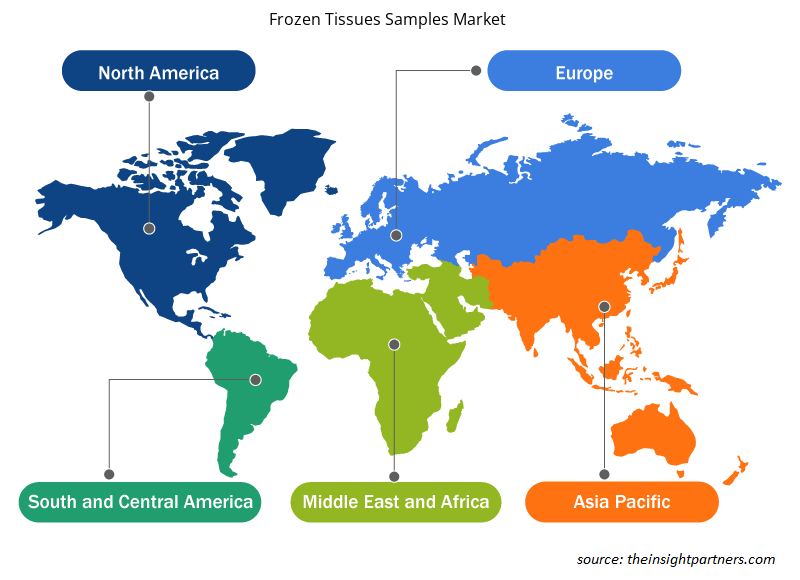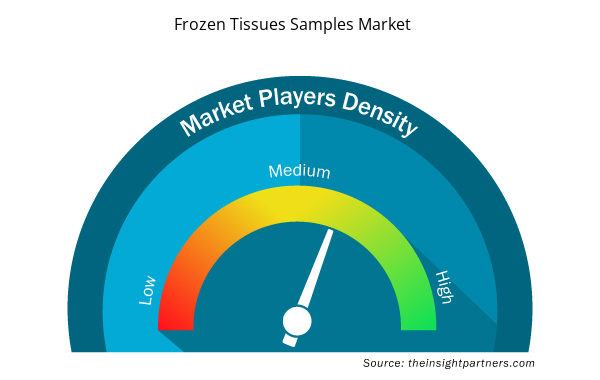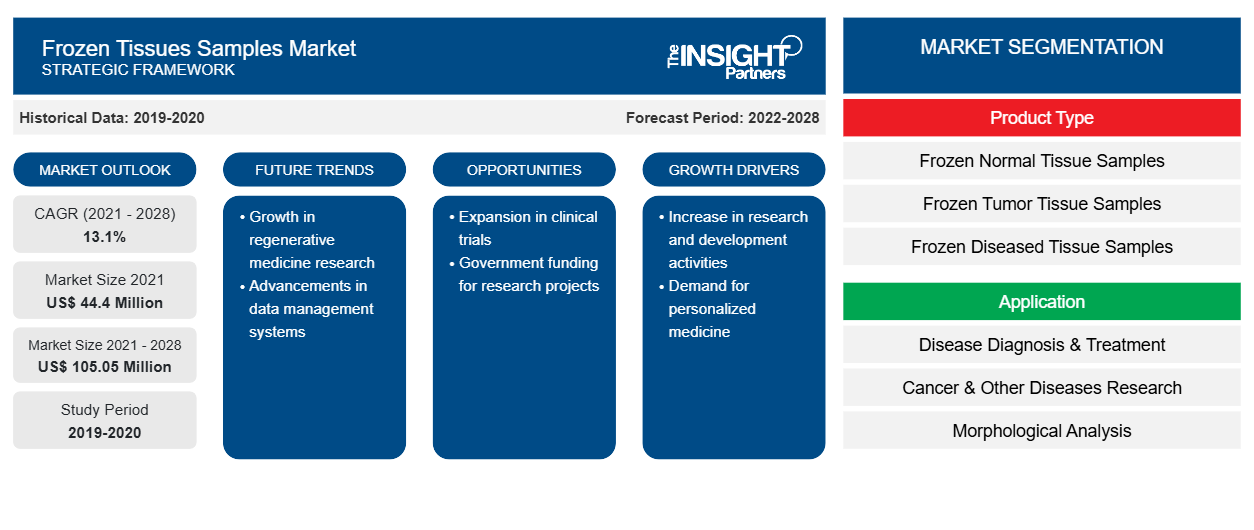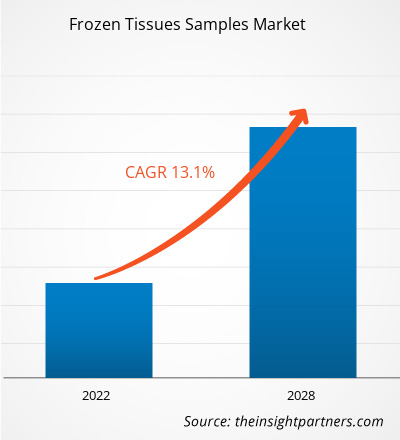Se proyecta que el mercado de muestras de tejidos congelados alcance los US$ 105.045,91 mil para 2028 desde los US$ 44.399,07 mil en 2021. Se estima que el mercado crecerá a una CAGR del 13,1% durante 2021-2028.
Las muestras de tejido congeladas son las preferidas en análisis como la secuenciación de próxima generación , el Western blotting para modificaciones postraduccionales de proteínas, la espectrometría de masas y la reacción en cadena de la polimerasa cuantitativa en tiempo real. Las muestras de tejido congeladas son el estándar de oro para la secuenciación de ADN y ARN, especialmente cuando las cadenas deben tener más de 50 pares. Las muestras de tejido congeladas también son útiles en inmunohistoquímica, ya que las proteínas aún se conservan en su estado nativo.
Personalice este informe según sus necesidades
Obtendrá personalización en cualquier informe, sin cargo, incluidas partes de este informe o análisis a nivel de país, paquete de datos de Excel, así como también grandes ofertas y descuentos para empresas emergentes y universidades.
- Obtenga las principales tendencias clave del mercado de este informe.Esta muestra GRATUITA incluirá análisis de datos, desde tendencias del mercado hasta estimaciones y pronósticos.
El crecimiento del mercado mundial de muestras de tejidos congelados se atribuye a la creciente aplicación de muestras de tejidos congelados en diversas áreas de investigación y terapéuticas y al uso cada vez mayor de muestras de tejidos congelados debido a la creciente prevalencia del cáncer. Sin embargo, el riesgo asociado con la conservación y el mantenimiento de muestras de tejidos congelados está obstaculizando el crecimiento del mercado mundial de muestras de tejidos congelados hasta cierto punto.
Aumento del uso de muestras de tejido congelado debido a la creciente prevalencia del cáncer
Según los datos publicados por Cancer Research UK en 2020, alrededor de 0,16 millones de personas en el Reino Unido mueren cada año a causa del cáncer. Además, según el informe de Globocan, en 2020, el cáncer de mama en mujeres superó al cáncer de pulmón como el cáncer más diagnosticado, con un estimado de 2,3 millones de casos nuevos (11,7%), seguido de los cánceres de pulmón (11,4%), colorrectal (10,0%), próstata (7,3%) y estómago (5,6%). El cáncer de pulmón siguió siendo la principal causa de muerte por cáncer, con un estimado de 1,8 millones de muertes (18%), seguido de los cánceres colorrectal (9,4%), de hígado (8,3%), de estómago (7,7%) y de mama en mujeres (6,9%). La incidencia general fue entre dos y tres veces mayor en los países en transición que en los que estaban en transición. Sin embargo, las muertes por cáncer de mama y de cuello uterino en mujeres fueron considerablemente mayores en los países en transición que en los que estaban en transición. Una prevalencia tan alta del cáncer está impulsando la necesidad de muestras de tejido congelado para investigación y estudio. Los estudios cada vez más numerosos que utilizan muestras de tejido tumoral congelado establecen varios alcances de diagnóstico y tratamiento para esta enfermedad crónica. Por lo tanto, la creciente incidencia del cáncer en todo el mundo está impulsando el crecimiento del mercado de muestras de tejido congelado. Además, en Canadá, el cáncer es la principal causa de muerte entre la población y se observa que es la segunda causa principal después de las enfermedades cardíacas en los EE. UU. Según la Sociedad Estadounidense del Cáncer, se diagnostican aproximadamente 1,9 millones de nuevos casos de cáncer y se estima que habrá 609 360 muertes en los EE. UU. en 2022. Los cánceres de próstata son los cánceres diagnosticados con mayor frecuencia entre los hombres en América del Norte; sin embargo, los cánceres de mama siguen siendo los principales en las mujeres. Además, el cáncer de pulmón sigue siendo la causa más común de muerte entre la población. Se estima que el número de nuevos casos de incidencia de cáncer es de 439,2 por cada 100 000 hombres y mujeres al año. Por lo tanto, la creciente prevalencia del cáncer entre la población está provocando el crecimiento del mercado de muestras de tejido congelado en todo el mundo.
Perspectivas basadas en productos
El mercado mundial de muestras de tejidos congelados, según el producto, se segmenta en muestras de tejidos normales congelados, muestras de tejidos tumorales congelados y muestras de tejidos enfermos congelados. El segmento de muestras tumorales de tejido congelado tuvo la mayor participación del mercado en 2021. Además, se prevé que el mismo segmento registre la CAGR más alta en el mercado de muestras de tejidos congelados durante el período de pronóstico de 2021 a 2028. El crecimiento se atribuye principalmente al aumento de casos de tumores a nivel mundial.
Perspectivas basadas en aplicaciones
Según la aplicación, el mercado mundial de muestras de tejidos congelados se segmenta en diagnóstico y tratamiento de enfermedades, investigación del cáncer y otras enfermedades y análisis morfológico. En 2021, el segmento de investigación del cáncer y otras enfermedades representó la mayor parte del mercado mundial de muestras de tejidos congelados. Sin embargo, se espera que el segmento de diagnóstico y tratamiento de enfermedades crezca a la tasa compuesta anual más rápida del 13,8 % entre 2021 y 2028.
Información basada en el usuario final
El mercado mundial de muestras de tejidos congelados, según el usuario final, está segmentado en institutos académicos y de investigación, hospitales y clínicas, centros de diagnóstico y otros. En 2021, el segmento de institutos académicos y de investigación tuvo la mayor participación en el mercado mundial de muestras de tejidos congelados. Sin embargo, se espera que el segmento de hospitales y clínicas crezca a la tasa compuesta anual más rápida del 13,9 % entre 2021 y 2028.CAGR of 13.9% from 2021 to 2028.
Los lanzamientos y aprobaciones de productos son estrategias que las empresas suelen adoptar para expandir su presencia global y sus carteras de productos. Además, los actores del mercado de muestras de tejidos congelados se centran en la estrategia de asociación para ampliar su clientela, lo que, a su vez, les permite mantener su marca a nivel mundial. Se prevé que el mercado mundial de muestras de tejidos congelados prospere con el desarrollo de nuevos productos innovadores por parte de los actores del mercado.
Perspectivas regionales del mercado de muestras de tejidos congelados
Los analistas de Insight Partners explicaron en detalle las tendencias y los factores regionales que influyen en el mercado de muestras de tejidos congelados durante el período de pronóstico. Esta sección también analiza los segmentos y la geografía del mercado de muestras de tejidos congelados en América del Norte, Europa, Asia Pacífico, Oriente Medio y África, y América del Sur y Central.

- Obtenga datos regionales específicos para el mercado de muestras de tejidos congelados
Alcance del informe de mercado de muestras de tejidos congelados
| Atributo del informe | Detalles |
|---|---|
| Tamaño del mercado en 2021 | US$ 44,4 millones |
| Tamaño del mercado en 2028 | US$ 105,05 millones |
| CAGR global (2021-2028) | 13,1% |
| Datos históricos | 2019-2020 |
| Período de pronóstico | 2022-2028 |
| Segmentos cubiertos | Por tipo de producto
|
| Regiones y países cubiertos | América del norte
|
| Líderes del mercado y perfiles de empresas clave |
|
Densidad de actores del mercado de muestras de tejidos congelados: comprensión de su impacto en la dinámica empresarial
El mercado de muestras de tejidos congelados está creciendo rápidamente, impulsado por la creciente demanda de los usuarios finales debido a factores como la evolución de las preferencias de los consumidores, los avances tecnológicos y una mayor conciencia de los beneficios del producto. A medida que aumenta la demanda, las empresas amplían sus ofertas, innovan para satisfacer las necesidades de los consumidores y aprovechan las tendencias emergentes, lo que impulsa aún más el crecimiento del mercado.
La densidad de actores del mercado se refiere a la distribución de las empresas o firmas que operan dentro de un mercado o industria en particular. Indica cuántos competidores (actores del mercado) están presentes en un espacio de mercado determinado en relación con su tamaño o valor total de mercado.
Las principales empresas que operan en el mercado de muestras de tejidos congelados son:
- Compañía de biociencias Audubon
- REPROCELL Inc.
- Bay Biosciences LLC
- Corporación Biolab de Estados Unidos, Inc.
- AMS Biotechnology (Europa) Ltd.
Descargo de responsabilidad : Las empresas enumeradas anteriormente no están clasificadas en ningún orden particular.

- Obtenga una descripción general de los principales actores clave del mercado de muestras de tejidos congelados
Perfiles de empresas
- Compañía de biociencias Audubon
- REPROCELL Inc.
- Bay Biosciences LLC
- Corporación Biolab de EE. UU., Inc.
- AMS Biotechnology (Europa) Ltd.
- Genetista, Inc.
- ZenBio, Inc
- Tecnologías OriGene, Inc.
- Instituto BioChain Inc.
- ProteoGenex, Inc.
- Análisis histórico (2 años), año base, pronóstico (7 años) con CAGR
- Análisis PEST y FODA
- Tamaño del mercado Valor/volumen: global, regional, nacional
- Industria y panorama competitivo
- Conjunto de datos de Excel



Report Coverage
Revenue forecast, Company Analysis, Industry landscape, Growth factors, and Trends

Segment Covered
This text is related
to segments covered.

Regional Scope
North America, Europe, Asia Pacific, Middle East & Africa, South & Central America

Country Scope
This text is related
to country scope.
Preguntas frecuentes
The Frozen Tissues Samples market majorly consists of the players such as Audubon Bioscience Co; REPROCELL Inc.; Bay Biosciences LLC; US Biolab Corporation, Inc; AMS Biotechnology (Europe) Ltd.; Geneticist, Inc.; ZenBio, Inc.; OriGene Technologies, Inc.; BioChain Institute Inc.; and ProteoGenex, Inc., among others.
The global Frozen Tissues Samples market is segmented by region into North America, Europe, Asia Pacific, Middle East & Africa, and South & Central America. Increasing incidence of cancer, growing need for diagnosing cancer, increasing competition between the market player, high R&D spending, and government grants for research institutes to develop new diagnosing methods are some of the prominent factors propelling the market growth in North America. Moreover, owing to the growing investments from international players in China and India. Aging population coupled with increasing demand for advanced medical technologies are expected to accelerate growth of the frozen tissues samples Market in Asia Pacific region.
In 2021, the academic and research institutes segment was likely to hold the largest share of the market. However, the hospitals and clinics segment is expected to witness growth in its demand at the fastest CAGR of 13.8% during 2021 to 2028.
The frozen tissue tumor samples segment was likely to hold the largest share of the market in 2021. Moreover, the same segment is anticipated to register the highest CAGR in the market during the forecast period of 2021 to 2028. The growth is mainly attributed due to increasing tumor cases globally.
The factors that are driving the growth of the market are rising application of frozen tissue samples in various research and therapeutic areas and risk associated with preservation and maintenance of frozen tissues samples. Moreover, the proliferation of biotechnology industry in developing regions provide growth opportunities to the frozen tissues samples market and developments in frozen tissue samples is expected to be a future trend that will drive the market’s growth in the coming years.
Frozen tissue samples are biospecimens preferred in analyses such as next-generation sequencing, western blotting for post-translational protein modifications, mass spectrometry, and quantitative real-time polymerase chain reaction. Frozen tissue samples are the gold standard for DNA and RNA sequencing, especially when the strands must be longer than 50 pairs. In immunohistochemistry, frozen tissue samples are also useful as the proteins are still preserved in their native state.
Trends and growth analysis reports related to Life Sciences : READ MORE..
The List of Companies - Frozen Tissues Samples Market
- Audubon Bioscience Co
- REPROCELL Inc.
- Bay Biosciences LLC
- US Biolab Corporation, Inc.
- AMS Biotechnology (Europe) Ltd.
- Geneticist, Inc.
- ZenBio, Inc.
- OriGene Technologies, Inc.
- BioChain Institute Inc.
- ProteoGenex, Inc.
The Insight Partners performs research in 4 major stages: Data Collection & Secondary Research, Primary Research, Data Analysis and Data Triangulation & Final Review.
- Data Collection and Secondary Research:
As a market research and consulting firm operating from a decade, we have published and advised several client across the globe. First step for any study will start with an assessment of currently available data and insights from existing reports. Further, historical and current market information is collected from Investor Presentations, Annual Reports, SEC Filings, etc., and other information related to company’s performance and market positioning are gathered from Paid Databases (Factiva, Hoovers, and Reuters) and various other publications available in public domain.
Several associations trade associates, technical forums, institutes, societies and organization are accessed to gain technical as well as market related insights through their publications such as research papers, blogs and press releases related to the studies are referred to get cues about the market. Further, white papers, journals, magazines, and other news articles published in last 3 years are scrutinized and analyzed to understand the current market trends.
- Primary Research:
The primarily interview analysis comprise of data obtained from industry participants interview and answers to survey questions gathered by in-house primary team.
For primary research, interviews are conducted with industry experts/CEOs/Marketing Managers/VPs/Subject Matter Experts from both demand and supply side to get a 360-degree view of the market. The primary team conducts several interviews based on the complexity of the markets to understand the various market trends and dynamics which makes research more credible and precise.
A typical research interview fulfils the following functions:
- Provides first-hand information on the market size, market trends, growth trends, competitive landscape, and outlook
- Validates and strengthens in-house secondary research findings
- Develops the analysis team’s expertise and market understanding
Primary research involves email interactions and telephone interviews for each market, category, segment, and sub-segment across geographies. The participants who typically take part in such a process include, but are not limited to:
- Industry participants: VPs, business development managers, market intelligence managers and national sales managers
- Outside experts: Valuation experts, research analysts and key opinion leaders specializing in the electronics and semiconductor industry.
Below is the breakup of our primary respondents by company, designation, and region:

Once we receive the confirmation from primary research sources or primary respondents, we finalize the base year market estimation and forecast the data as per the macroeconomic and microeconomic factors assessed during data collection.
- Data Analysis:
Once data is validated through both secondary as well as primary respondents, we finalize the market estimations by hypothesis formulation and factor analysis at regional and country level.
- Macro-Economic Factor Analysis:
We analyse macroeconomic indicators such the gross domestic product (GDP), increase in the demand for goods and services across industries, technological advancement, regional economic growth, governmental policies, the influence of COVID-19, PEST analysis, and other aspects. This analysis aids in setting benchmarks for various nations/regions and approximating market splits. Additionally, the general trend of the aforementioned components aid in determining the market's development possibilities.
- Country Level Data:
Various factors that are especially aligned to the country are taken into account to determine the market size for a certain area and country, including the presence of vendors, such as headquarters and offices, the country's GDP, demand patterns, and industry growth. To comprehend the market dynamics for the nation, a number of growth variables, inhibitors, application areas, and current market trends are researched. The aforementioned elements aid in determining the country's overall market's growth potential.
- Company Profile:
The “Table of Contents” is formulated by listing and analyzing more than 25 - 30 companies operating in the market ecosystem across geographies. However, we profile only 10 companies as a standard practice in our syndicate reports. These 10 companies comprise leading, emerging, and regional players. Nonetheless, our analysis is not restricted to the 10 listed companies, we also analyze other companies present in the market to develop a holistic view and understand the prevailing trends. The “Company Profiles” section in the report covers key facts, business description, products & services, financial information, SWOT analysis, and key developments. The financial information presented is extracted from the annual reports and official documents of the publicly listed companies. Upon collecting the information for the sections of respective companies, we verify them via various primary sources and then compile the data in respective company profiles. The company level information helps us in deriving the base number as well as in forecasting the market size.
- Developing Base Number:
Aggregation of sales statistics (2020-2022) and macro-economic factor, and other secondary and primary research insights are utilized to arrive at base number and related market shares for 2022. The data gaps are identified in this step and relevant market data is analyzed, collected from paid primary interviews or databases. On finalizing the base year market size, forecasts are developed on the basis of macro-economic, industry and market growth factors and company level analysis.
- Data Triangulation and Final Review:
The market findings and base year market size calculations are validated from supply as well as demand side. Demand side validations are based on macro-economic factor analysis and benchmarks for respective regions and countries. In case of supply side validations, revenues of major companies are estimated (in case not available) based on industry benchmark, approximate number of employees, product portfolio, and primary interviews revenues are gathered. Further revenue from target product/service segment is assessed to avoid overshooting of market statistics. In case of heavy deviations between supply and demand side values, all thes steps are repeated to achieve synchronization.
We follow an iterative model, wherein we share our research findings with Subject Matter Experts (SME’s) and Key Opinion Leaders (KOLs) until consensus view of the market is not formulated – this model negates any drastic deviation in the opinions of experts. Only validated and universally acceptable research findings are quoted in our reports.
We have important check points that we use to validate our research findings – which we call – data triangulation, where we validate the information, we generate from secondary sources with primary interviews and then we re-validate with our internal data bases and Subject matter experts. This comprehensive model enables us to deliver high quality, reliable data in shortest possible time.


 Obtenga una muestra gratuita de este informe
Obtenga una muestra gratuita de este informe